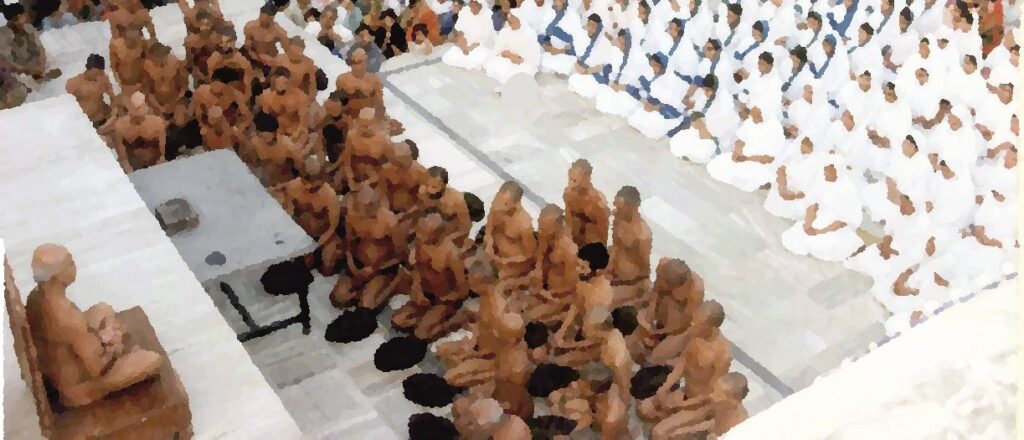हैशटैग
#Devnandi(Prachin)


It is an important work of Acharya Vidyanand. It is also mentioned by the names 'Aptamimansalankar', 'Apatamimansalankriti', 'Devagamalankar' and 'Devagamalankriti'. It has 1 octahedral 0 paragraphs. each paragraph
In the Pushpika-sentence which is at the end of it, its name is given as Aptamimansalankriti.
has gone. In the verse given by Acharya Vidyanand at the beginning of the second section, its name has been given as Ashtasahasri. that verse is like this
Shrotvyashta Sahasri Shrutaih Kimanyaih Sahasra Numbernaih. Vigyayate yathaiva swam sam pe time sambhavnah.. It has also been called Devagamalankriti and Devagamalankar in Apapariksha. Ashtasahasri is a very detailed and theorem-rich explanation of Aptamimansa. In this the Ashtashati of Acharya Aklank Dev has been assimilated. Without Ashtasahasri, the mystery of Ashtashati cannot be understood.Acharya Vidyanand has written a verse at the end of Ashtasahasri, in which Ashtasahasri has been described as Vardhaman by the utterances of Kumarasena. that verse is as follows
Pushyat in the troubled Sahasri Siddha Sashtasahsriyamanna.
Shashvadbhishta Sahastri Kumar Senokti Vardhamanartha. This means that an Acharya named Kumar Sen had written something on Aptamimamsa and Acharya Vidyanand took advantage of it. In this verse, Ashtasahasri has also been called as Kashtasahasri, it is known from this that thousands of sufferings had to be endured in the creation of Ashtasahasri. Its study is also painful.That is, a student can study Ashtasahasri only after suffering thousands of hardships. Acharya Vidyanand, author of Ashta Sahastri
After Acharya Aklank, the founder of Jain justice, Shri Vidyanand ji
Prashammurti Acharya Shantisagar Chhani Memorial Book
आचार्य विद्यानन्द की एक महत्त्वपूर्ण कृति है। इसका 'आप्तमीमांसालंकार', 'आप्तमीमांसालंकृति', 'देवागमालंकार' और देवागमालंकृति' इन नामों से भी उल्लेख किया गया है। इसमें 1 अष्टसहस्री 0 परिच्छेद हैं।
प्रत्येक परिच्छेद के अन्त में जो पुष्पिका-वाक्य है उनमें इसका नाम आप्तमीमांसालंकृति दिया
गया है। द्वितीय परिच्छेद के प्रारंभ में आचार्य विद्यानन्द ने जो पद्य दिया है उसमें इसका नाम अष्टसहस्री बतलाया है। वह पद्य इस प्रकार है
श्रोतव्याष्टसहस्री श्रुतैः किमन्यैः सहस्र संख्यानैः।
विज्ञायते यथैव स्वसमय पर समय सद्भावः।। आप्तपरीक्षा में इसे देवागमालंकृति और देवागमालंकार भी कहा है। अष्टसहस्री आप्तमीमांसा की अत्यन्त विस्तृत और प्रमेयबहुल व्याख्या है। इसमें आचार्य अकलंक देव की अष्टशती को आत्मसात् कर लिया गया है। अष्टसहस्री के बिना अष्टशती का गूढ़ रहस्य समझ में नहीं आ सकता है। आचार्य विद्यानन्द ने अष्टसहस्री के अन्त में एक श्लोक लिखा है जिसमें अष्टसहस्री को कुमारसेन की उक्तियों से वर्धमान बतलाया है। वह श्लोक निम्न प्रकार है
कष्टसहस्त्री सिद्धा साष्टसहस्रीयमन्न मे पुष्यात्।
शश्वदभीष्टसहस्त्री कुमार सेनोक्ति वर्धमानार्था।। इसका तात्पर्य यही है कि कुमार सेन नामक आचार्य ने आप्तमीमांसा पर कुछ लिखा था और आचार्य विद्यानन्द ने उससे लाभ उठाया था। इस श्लोक में अष्टसहस्री को कष्टसहस्री भी कहा है, इससे ज्ञात होता है कि अष्टसहस्री की रचना में हजारों कष्टों को सहन करना पड़ा था। इसका अध्ययन भी कष्टकारी है। अर्थात् कोई जिज्ञासु हजारों कष्ट उठाकर ही अष्टसहस्री का अध्ययन कर सकता है। अष्टसहस्त्री के रचयिता आचार्य विद्यानन्द
जैन न्याय के प्रतिष्ठापक आचार्य अकलंक के बाद श्री विद्यानन्द जी
प्रशममूर्ति आचार्य शान्तिसागर छाणी स्मृति-ग्रन्थ
Smirthi Granth
#Devnandi(Prachin)
Smirthi Granth
आचार्य श्री १०८ देवनंदी
| Name | Phone/Mobile 1 | Which Sangh/Maharaji/Aryika Ji you are associated with |
|---|---|---|
| Sangh Common Number | +919844033717 | #VardhamanSagarJiMaharaj1950DharmSagarJi |
| Hemal Jain | +918690943133 | #SunilSagarJi1977SanmatiSagarJi |
| Abhi Bantu | +919575455473 | #SunilSagarJi1977SanmatiSagarJi |
| Purnima Didi | +918552998307 | #SunilSagarJi1977SanmatiSagarJi |
| Varna Manish Bhai | +919352199164 | #KanaknandiJiMaharajKunthusagarji |
| Ankit Test | +919730016352 | #AcharyaShriVidyasagarjiMaharaj |
| Santosh Khule | +919850774639 | #PavitrasagarJiMaharaj1949SanmatiSagarJi1927 |
| Madhok Shaha | +919928058345 | #KanaknandiJiMaharajKunthusagarji |
| Siddharth jain Baddu | +917987281995 | #AcharyaShriVidyasagarjiMaharaj, #VishalSagarJiMaharaj1977VidyaSagarJi |
| Akshay Adadande | +919765069127 | #AcharyaShriVidyasagarjiMaharaj, #NiyamSagarJiMaharaj1957VidyaSagarJi |
| Mayur Jain | +918484845108 | #SundarSagarJiMaharaj1976SanmatiSagarJi, #VibhavSagarJiMaharaj1976ViragSagarJi, #PrabhavsagarjiPavitrasagarJiMaharaj1949, #MayanksagarjiRayansagarJiMaharaj1955 |
Nutan Chougule created Digjainwiki Hindi page for Acharya on 26th June 2021
Nutan Chougule created Digjainwiki page for Acharya on 26th June 2021
Smrithi Granth
It is an important work of Acharya Vidyanand. It is also mentioned by the names 'Aptamimansalankar', 'Apatamimansalankriti', 'Devagamalankar' and 'Devagamalankriti'. It has 1 octahedral 0 paragraphs. each paragraph
In the Pushpika-sentence which is at the end of it, its name is given as Aptamimansalankriti.
has gone. In the verse given by Acharya Vidyanand at the beginning of the second section, its name has been given as Ashtasahasri. that verse is like this
Shrotvyashta Sahasri Shrutaih Kimanyaih Sahasra Numbernaih. Vigyayate yathaiva swam sam pe time sambhavnah.. It has also been called Devagamalankriti and Devagamalankar in Apapariksha. Ashtasahasri is a very detailed and theorem-rich explanation of Aptamimansa. In this the Ashtashati of Acharya Aklank Dev has been assimilated. Without Ashtasahasri, the mystery of Ashtashati cannot be understood.Acharya Vidyanand has written a verse at the end of Ashtasahasri, in which Ashtasahasri has been described as Vardhaman by the utterances of Kumarasena. that verse is as follows
Pushyat in the troubled Sahasri Siddha Sashtasahsriyamanna.
Shashvadbhishta Sahastri Kumar Senokti Vardhamanartha. This means that an Acharya named Kumar Sen had written something on Aptamimamsa and Acharya Vidyanand took advantage of it. In this verse, Ashtasahasri has also been called as Kashtasahasri, it is known from this that thousands of sufferings had to be endured in the creation of Ashtasahasri. Its study is also painful.That is, a student can study Ashtasahasri only after suffering thousands of hardships. Acharya Vidyanand, author of Ashta Sahastri
After Acharya Aklank, the founder of Jain justice, Shri Vidyanand ji
Prashammurti Acharya Shantisagar Chhani Memorial Book
Smrithi Granth
Nutan Chougule created Digjainwiki page for Acharya on 26th June 2021
#Devnandi(Prachin)
15000
Acharya Shri 108 Devnandi (Prachin)
#Devnandi(Prachin)
Devnandi(Prachin)
You cannot copy content of this page